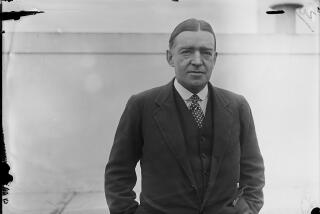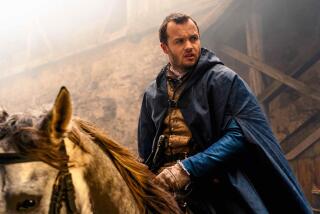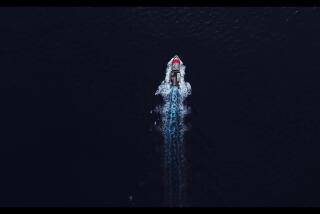Out of the Cold, Cold Past
In modern times, Ernest Shackletonâs 1914 Antarctic expedition must rank as the greatest story never told. His disastrous quest to be the first to cross the frigid continentâs 1,500 miles with sled dogs has pretty much remained buried since it faded from the headlines more than 80 years ago.
The British polar explorer and his 27-man crew never made it to Antarctica but instead endured a two-year ordeal on ice--an ordeal that amazingly all the men survived.
âItâs no accident the story retains the power it has because it has a sort of classic dimension, larger than its time,â said Kenneth Branagh, who plays the charismatic Anglo-Irishman in the upcoming A&E; miniseries âShackleton.â âAnd [thereâs] the parallel it holds for our own experience, the absolutely implicit notion that you cannot fail if you are trying. The story seems at the same time sort of insignificant and also profoundly important.â
Important enough, it seems, to be the subject of no less than half a dozen projects, including a $7.5-million Imax film shot in Antarctica that re-creates the voyage, a $3.5-million feature documentary, the A&E; miniseries, a âNovaâ TV documentary, a nationally touring museum exhibition and several books.
(A possible big-screen Hollywood version of the Shackletonâs tale is still pending, however. German director Wolfgang Petersen [âDas Boot,â âThe Perfect Stormâ] has dreamed of making such a film for more than a decade, according to a spokeswoman, but the project remains on hold.)
It is a saga that is fueling what has been called âShackleton fever.â
âItâs been phenomenal,â said Natasha Dworkin at the Burke Museum of Natural History in Seattle, where the exhibition drew three times the usual crowds before closing in December. âSeattle is in a Shackleton vortex.â
Just one day shy of reaching Antarctica after leaving England on Aug. 8, 1914, Shackletonâs ship, the Endurance, became frozen solid in the waters of the Weddell Sea. It was later crushed by the powerful pressure of the ice and sank. For two years, Shackleton and his men struggled to return to civilization while staving off starvation and death--they camped on ice floes, rowed hundreds of miles in tiny life boats on surging seas, and lived off seals and penguins on a bleak, uninhabited island.
âIt is impossible for anyone to explain how 28 men lived for 635 days marooned, essentially, on an iceberg,â said director George Butler, who himself was trapped briefly in the same Antarctic ice while filming the Imax movie âShackletonâs Antarctic Adventure.â âThe story is one of the greatest stories ever. Itâs Homerian.â
In his day, Shackleton lived in the shadow of the steely Robert F. Scott, who became an instant hero in Britain when he died after planting a Union Jack on the South Pole in 1912. Although Norwegian Roald Amundsenâs team had beaten him to the pole in the biggest exploration race of the early 20th century, Scottâs icy end in a blizzard just 11 miles from his camp set the nation mourning.
Shackleton and his men, in contrast, returned from the maw of white death in 1916 to an indifferent nation, one mired in the staggering casualties of World War I, one where heroes were made on the battlefield, not on the ice floes of the Antarctic.
Now, Shackletonâs star has risen almost as fast as Rudy Giulianiâs--and for many of the same reasons. As a terrorized America redefines its notion of heroism and as Shackletonâs story sweeps into pop culture, this forgotten explorer is emerging as a hero for our time, a man who saved his men by putting their welfare above all else.
âHe is a particular kind of hero for Americans,â said Susanne Simpson, executive producer of the 40-minute Imax film, which debuted in New York in February 2001 and was co-produced by White Mountain Films and Nova/WGBH Boston. âHeâs extremely optimistic, he believes in teamwork and he dedicated himself to saving his men. He did make mistakes, but the truth is he did his personal best, and in this case his personal best was that everybody survived.â
Bringing the drawn-out saga to the small, big and extra-big screen was both a logistical nightmare and a filmmakerâs dream. The nightmare--filming on location at the edge of constantly changing ice--dogged the Imax crew off Antarctica and the A&E; cast off Greenland. But the dream was drawing on original photographs and film footage shot by crew member Frank Hurley, an Australian photographer Shackleton had hired to document the trip.
Director Butlerâs 2000 feature film, made with his White Mountain Films and Nova/WGBH Boston, was the highest grossing theatrical documentary in 2001, taking in a little more than $2 million to date, according to Daily Variety. Narrated by Liam Neeson, âThe Endurance: Shackletonâs Legendary Antarctic Expeditionâ (which carries the same title and is based on the touring museum exhibition and its accompanying book) tells the story in a straightforward way, using Hurleyâs arresting images interspersed with interviews with historians and descendants of crew members. One of the most chilling scenes is that of the breakup and sinking of the Endurance, a moment Hurley records in his diary: âAwful calamity that has overtaken the ship that has been our home for over 12 months....We are homeless and adrift on the sea ice.â
In âShackletonâs Antarctic Adventure,â the Imax film also directed by Butler, location and authenticity were key to the re-creation. âIn the perspective of Imax, itâs really important that the audience experience being there,â executive producer Simpson said.
But itâs A&E;âs dramatic miniseries âShackleton,â airing April 7-8, that attempts to flesh out a more telling portrait of the explorer, warts and all. In the first part, writer-director Charles Sturridge shows Shackleton as a hapless but enthusiastic businessman talking up his expedition to potential contributors while remaining largely indifferent to his wife and children. âHis personal and family life were very confused,â Sturridge said. âHe was not a perfect father, not a perfect husband and he had numerous affairs.â
Shackletonâs voyage into modern times started about three years ago with a cat, specifically one Mrs. Chippy who was a passenger on the Endurance.
Writer Caroline Alexander was transfixed by the story of what Shackleton named the Imperial Trans-Antarctic Expedition.
âI had no intention of writing the Endurance story,â she recalled. âI was entranced with these little references to the cat and, in a way, I felt the other stuff had all been written.â
She wrote and published âMrs. Chippyâs Last Expedition,â which she described as âa diary of sorts written through the eyes of a very complacent, self-assured, pompous cat who clearly believed at the back of his mind that heâs running the expedition.â (Despite the name, Mrs. Chippy turned out to be a male.)
Traveling to England and reading crew membersâ original diaries at the Royal Geographic Society in London and the Scott Polar Research Institute in Cambridge, Alexander made another startling discovery. âI was stunned to see there was an enormous collection [of photographs] and the quality of the images was world-class,â Alexander said. She had found the work of Hurley, whom Shackleton had hired after selling off exclusive photo and film rights.
Alexander immediately realized the value of the powerful photographs and persuaded the American Museum of Natural History in New York to mount an exhibition. The show needed a catalog, and, as Alexander tells it, âthatâs how I came to write the story of the grown-up men and not the cat.â
In her book âThe Endurance: Shackletonâs Legendary Antarctic Expedition,â Alexander portrays âthe Boss,â as his crew affectionately called him, as a leader who fostered a close camaraderie with his men, regardless of their stations on the ship. He kept them on strict routines of exercising the sled dogs, scrubbing the decks and cooking while the ship was stuck in the ice. In the bleak evenings, they would entertain each other by singing or, one night, with a haircut contest in which they took turns shearing off each otherâs locks--an event Hurley captured on film.
The crew spent a year on the static ship before watching it succumb to the pressure of the ice, dragging off precious supplies and three 21-foot rescue boats. Meanwhile, the fate of the Endurance was unknown back in England.
When the ice began to break up, Shackleton ordered the men into the life boats. They rowed about 100 miles for more than a week before landing on Elephant Island, a land so forbidding no ships ever visited. âItâs the outpost of the devil,â said Butler, who stopped there six times in the course of filming.
From there, Shackleton took five men in the sole remaining seaworthy boat on a 750-mile journey in hopes of reaching a whaling station on South Georgia Island. Hurricane-force winds forced them to land on the uninhabited side of the island, which left Shackleton and two of the men with no recourse but to cross the islandâs uncharted mountains on foot.
âAt every juncture in the Shackleton story, some kind of miracle took place,â Butler said. âHere are three men who donât have a map, donât know how to get around the mountain ranges in front of them ... and they traveled mostly at night.â
The three walked for 36 hours straight and finally heard the first sign of civilization--a whistle blowing at the whaling station--they had experienced in a year and a half.
In the Imax film, three world-class mountaineers--Reinhold Messner, Conrad Anker and Stephen Venables--followed the route Shackleton took across South Georgia Island.
Even with modern equipment and clothing--and the luxury of not having lived out in the Antarctic for more than a year--it took the team three days to complete the crossing.
Anker said that for the most part, he and his climbing partners faithfully followed Shackletonâs footsteps, though the terrain had changed dramatically. âThe Boss was an awesome guy. He always said, âOnward,ââ Anker said.â
After a few abortive rescue attempts, Shackleton returned to Elephant Island three months later, on Aug. 30, 1916, to find all 22 men still alive. He scribbled a note to his wife: âI have done it....Not a life lost and we have been through Hell.â
It was Alexanderâs book and Hurleyâs photos that inspired Butler, director of the 1977 documentary âPumping Iron,â to team with Nova/WGBH Boston to direct the Imax film and to make the documentary feature.
âHurley became this marvelous witness to the event,â Butler said. âHe needed 200 pounds of equipment just to expose a frame of film. He had to hand-crank [the movie camera] at a perfect 19 frames per second, with no assistant in subzero conditions.â
Hurleyâs photographs are the heart of the exhibition scheduled to come to the Los Angeles Museum of Natural History on June 9.
After his dramatic survival and perseverance on the Endurance, Shackleton died on South Georgia Island in 1922 at age 47.
He had embarked on an ill-defined expedition to the Antarctic with some of his crew members from the Endurance but suffered a massive heart attack when they reached South Georgia--dying on the very island he had struggled to cross six years earlier with the sole thought of saving his men.
Perhaps what speaks to contemporary audiences most about Shackleton is how he kept up the hopes of his crew, carefully monitoring his men for signs of despair. He refused, for example, to allow them to stockpile large numbers of penguins and seals for food, fearing it would dull their motivation to go home.
Noted âShackletonâ miniseries director Sturridge: âHe had the ability to simultaneously tell the truth to his companions while also giving them something to hope for.â
*
A Timeline of Disaster: Shackletonâs Expedition
1914
Aug. 8: Ernest Shackletonâs ship, the Endurance, departs England.
Dec. 7: The Endurance first encounters sea ice.
1915
Jan. 18: The Endurance becomes trapped in ice and, immobilized, begins drifting.
Oct. 27: Shackleton gives the orders to abandon the ship, which is severely damaged by the ice.
Nov. 21: The Endurance sinks.
Dec. 29: After a failed attempt to march across the ice to the safety of land, Shackleton establishes Patience Camp.
1916
April 9: Shackleton orders the lifeboats to be launched.
April 16: The three boats land on Elephant Island, a remote, uninhabited spot far from shipping lanes. This is the first time the men have stood on solid ground in 497 days.
April 24: Shackleton decides to sail one of the boats, the James Caird, to South Georgia, the site of a whaling station, to get help.
May 10: The James Caird arrives on the uninhabited south coast of South Georgia Island.
May 19: Shackleton and two others begin their trek across the islandâs unexplored interior to get help at the whaling station, on the north coast.
May 20: Shackleton and his men arrive at the whaling station.
May 23: Shackleton borrows a ship and sails for Elephant Island to rescue his men. The pack ice prevents passage, and the ship returns. Two subsequent rescue attempts are also stopped by ice.
Aug. 25: Shackleton again departs for Elephant Island on a tug.
Aug. 30: Shackleton rescues the 22 men on Elephant Island.
Sources: WGBH Educational Foundation; the book âThe Endurance, Shackletonâs Legendary Antarctic Expedition.â
*
Shackleton on Screen and in the Museum
* âThe Endurance: Shackletonâs Legendary Antarctic Expedition,â a 90-minute documentary feature, is in limited release.
An exhibition of the same title featuring Frank Hurleyâs original photographs will be on display at the Natural History Museum of Los Angeles County from June 9 through Sept. 2.
For more information, visit www.amnh.org/exhibitions/shackleton/exhibition.html. The accompanying book from Knopf is written by Caroline Alexander.
âShackletonâs Voyage of Endurance,â a two-hour âNovaâ TV documentary, is scheduled to air today at 2:30 p.m. on KCET. For more information, visit www.pbs.org/nova/shackle ton.
âShackleton,â a Channel Four International/A&E; dramatic miniseries starring Kenneth Branagh. The first part airs 8 p.m. April 7; the second part, 9 p.m. April 8.
*
Mary Forgione is a Times staff writer.
More to Read
The biggest entertainment stories
Get our big stories about Hollywood, film, television, music, arts, culture and more right in your inbox as soon as they publish.
You may occasionally receive promotional content from the Los Angeles Times.











